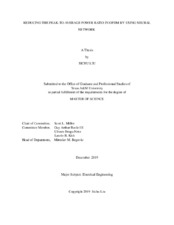| dc.contributor.advisor | Scott L, Miller, | |
| dc.creator | Liu, Sichu | |
| dc.date.accessioned | 2020-08-26T18:49:49Z | |
| dc.date.available | 2020-08-26T18:49:49Z | |
| dc.date.created | 2019-12 | |
| dc.date.issued | 2019-11-13 | |
| dc.date.submitted | December 2019 | |
| dc.identifier.uri | https://hdl.handle.net/1969.1/188765 | |
| dc.description.abstract | Orthogonal Frequency Division Multiplexing (OFDM) is an approach for realizing high speed transmission of data. The OFDM modulation scheme has the advantage of providing high spectral efficiency in multicarrier transmission of high data rate. One disadvantage of OFDM is that it has a high Peak-to-Average Power Ratio (PAPR) which leads to stricter linearity requirements for power amplifiers.
This necessary increase in the linear range of the power amplifier results in low power efficiency. Many PAPR reduction techniques use optimization algorithms to iteratively find a locally optimal point. In this project, we focus on the task of training neural networks which can produce signals with close performance to PAPR reduction methods using convex optimization. Also, we use unsupervised learning to train neural networks to find its own algorithm to achieve PAPR reduction. | en |
| dc.format.mimetype | application/pdf | |
| dc.language.iso | en | |
| dc.subject | OFDM | en |
| dc.subject | PAPR | en |
| dc.subject | neural networks | en |
| dc.title | Reducing the Peak-to-Average Power Ratio in OFDM by Using Neural Network | en |
| dc.type | Thesis | en |
| thesis.degree.department | Electrical and Computer Engineering | en |
| thesis.degree.discipline | Electrical Engineering | en |
| thesis.degree.grantor | Texas A&M University | en |
| thesis.degree.name | Master of Science | en |
| thesis.degree.level | Masters | en |
| dc.contributor.committeeMember | Battle, Guy Arthur III | |
| dc.contributor.committeeMember | Ulisses, Braga-Neto | |
| dc.contributor.committeeMember | Laszlo B, Kish | |
| dc.type.material | text | en |
| dc.date.updated | 2020-08-26T18:49:49Z | |
| local.etdauthor.orcid | 0000-0002-3045-8659 | |


